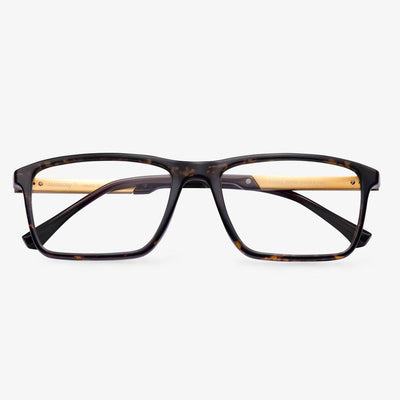What is the processing technology to make the lens thin?
For myopic lenses, the larger the diameter, the thicker the edge. Therefore, for customers with high myopia, we will recommend frames with smaller ring diameters, so that the edges of the processed lenses will be thinner. The edges of farsightedness lenses are already very thin (convex lenses are thick in the middle and thin on the sides), and the key determinant of lens thickness is the center thickness. In addition to the refractive index, which affects the thickness of the farsightedness lens, the influence of diameter is more important. Therefore, for patients with farsightedness, the most effective way to make lenses lighter and thinner is to choose a smaller frame and then customize a pair of lenses with the right diameter.
The categories of rimless glasses
Rimless glasses can be divided into metal rimless glasses and plastic rimless glasses according to the material. According to the metal category, they can be divided into nickel-copper alloy, memory titanium alloy rimless frames.
According to the elastic order of the frame, the softest and elastic kind is the plastic rimless glasses. The benefits are the lightest weight and the lowest price. The disadvantages are the short service life, faded look after the sun, and single appearance, which are suitable for children or teenagers in the stage of corrective treatment. The second elasticity is the memory titanium alloy rimless frame. They use aviation metal titanium as the raw material, suitable for people with sensitive skin, and have lighter quality, better durability, more styles.
Can you wear blue light glasses while driving?
The damage of blue light has a cumulative effect. The longer the exposure time is, the more serious the damage of retinal cells will be, which will eventually lead to irreversible damage of the structure and function of the retina. Once the retina has permanent damage, degeneration will directly affect the metabolism and function of photoreceptor cells, resulting in vision loss. It depends on the glasses you're wearing. The function of anti-blue light glasses depends on the material of the glasses. Some blue light glasses have a special anti-reflective coating, which can reduce glare. These glasses are definitely helpful when driving at night.
What Are the Disadvantages of High-Index Lenses?
This section will show high index lenses disadvantages.
- High index lenses are made from a chemical synthetic blend that’s created through a special manufacturing process. So, high index lenses are expensive than regular lenses. In fact, the price may be more than double that of the traditional counterparts.
- High index lenses can be more brittle than their traditional counterparts and may also be more prone to scrapes and scratches. This can impact their overall durability.
- High index lenses are more reflective than regular lenses, which can make them less effective for brightly lit work environments, outdoor use and nighttime driving on busy highways.
- High index lenses have greater potential for distortion, particularly in your peripheral vision because the high index lenses have a higher Abbe value than prescriptions made from standard plastic or glass.
Benefits of Saddle Bridge Glasses.
The most common type of plastic bridge is called a saddle bridge. The style is very comfortable because it distributes the weight of the glasses over a larger area rather than focusing on smaller points, like adjustable nose pads. Saddles are known to cost less to repair because they have fewer moving parts and are possible to maintain their fitness. There is now a new saddle bridge-type transparent silicone cushion for a screw-type nose pad. It is made of medical-grade soft silicone. It can be bent and is very soft. To fit the curve of the nose, a plastic frame with a saddle or keyhole bridge can slip off the nose without proper support. Silicone is a soft and elastic material that can be formed according to the contour and shape of the nose.
Transition Lenses Problems
It is not convenient to rely on photochromic lenses when driving. It also may be unsafe if the driver depends on the prescription to see or is legally bound to wear prescription lenses when driving.
Besides, transition lenses are typically the size and shape of regular vision-correction lenses, which allows them to accurately correct the field of vision, but does not account for peripheral areas on either side of the visible range. Sunglasses operate by maintaining very dark glasses that expand over the field of vision and the peripheral with large, oblong lenses that block sunlight from both the front and sides. However, transition lenses are not typically dark enough for heavy sun and cannot block light penetration on the peripheral, leading to people having to resort to sunglasses again.
Of course, there are some benefits of transition lenses and you can click here to learn more.
What Is Trivex Lens?
Trivex is another light, impact-resistant eyeglasses lenses. Like polycarbonate lens, Trivex is an excellent lens material for safety applications and children’s eyewear.
Trivex lenses are made of a urethane-based monomer. They are produced using a slower, cast molding process similar to how regular plastic lenses are made. The liquid lens material is slowly baked until is set. This gives Trivex lenses the advantages of sharper optics than injection-molded polycarbonate lenses.











































